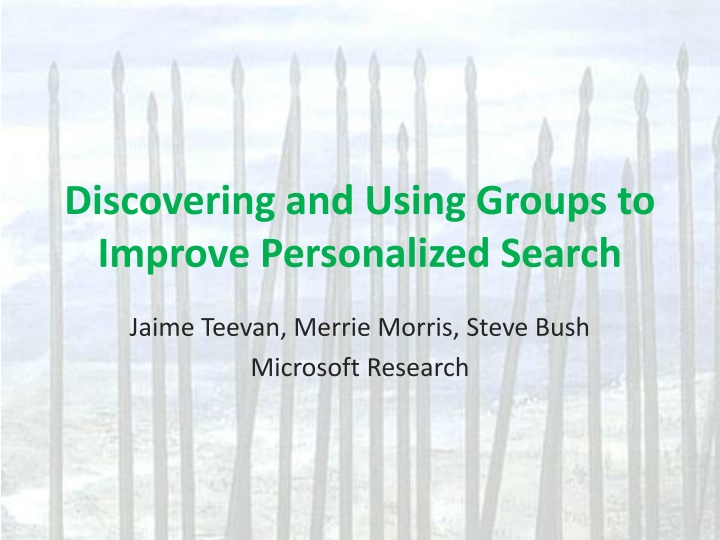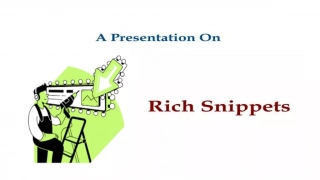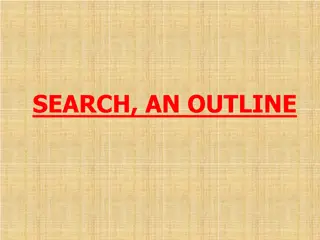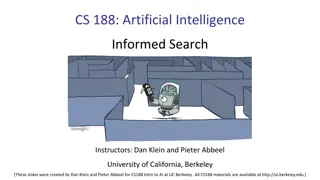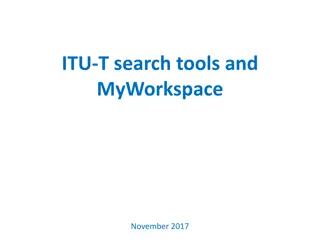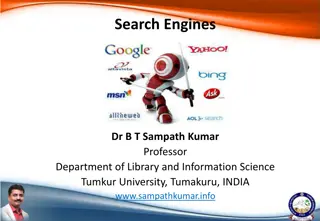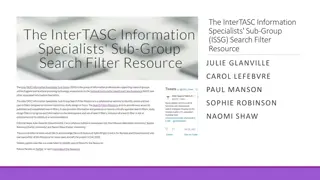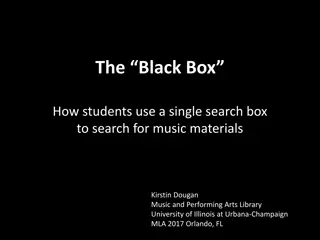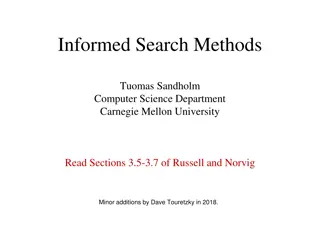Enhancing Search Personalization Through Group Dynamics
Exploring the use of group behavior to improve personalized search results, this study delves into understanding shared interests, communication patterns, and algorithmic strategies. By leveraging group dynamics, the research aims to bridge the gap in personalized search experiences, highlighting the importance of groupization in enhancing relevance and user satisfaction.
Download Presentation

Please find below an Image/Link to download the presentation.
The content on the website is provided AS IS for your information and personal use only. It may not be sold, licensed, or shared on other websites without obtaining consent from the author.If you encounter any issues during the download, it is possible that the publisher has removed the file from their server.
You are allowed to download the files provided on this website for personal or commercial use, subject to the condition that they are used lawfully. All files are the property of their respective owners.
The content on the website is provided AS IS for your information and personal use only. It may not be sold, licensed, or shared on other websites without obtaining consent from the author.
E N D
Presentation Transcript
Discovering and Using Groups to Improve Personalized Search Jaime Teevan, Merrie Morris, Steve Bush Microsoft Research
People Express Things Differently Differences can be a challenge for Web search Picture of a man handing over a key. Oil painting of the surrender of Breda.
People Express Things Differently Differences can be a challenge for Web search Picture of a man handing over a key. Oil painting of the surrender of Breda. Personalization Closes the gap using more about the person Groupization Closes the gap using more about the group
How to Take Advantage of Groups? Who do we share interests with? Do we talk about things similarly? What algorithms should we use?
Related Work Personalization Implicit information valuable [Dou et al. 2007; Shen et al. 2005] More data = better performance [Teevan et al. 2005] Collaborative filtering & recommender systems Identify related groups Browsed pages [Almeida & Almeida 2004; Sugiyama et al. 2005] Queries [Freyne & Smyth 2006; Lee 2005] Location [Mei & Church 2008], company [Smyth 2007], etc. Use group data to fill in missing personal data Typically data based on user behavior
How We Answered the Questions Who do we share interests with? Similarity in query selection Similarity in what is considered relevant Do we talk about things similarly? Similarity in user profile What algorithms should we use? Groupize results using groups of user profiles Evaluate using groups relevance judgments Evaluate using groups relevance judgments Evaluate using groups relevance judgments Evaluate using groups relevance judgments Who do we share interests with? Similarity in query selection Similarity in what is considered relevant Do we talk about things similarly? Similarity in user profile What algorithms should we use? Groupize results using groups of user profiles Groupize results using groups of user profiles Groupize results using groups of user profiles Who do we share interests with? Similarity in query selection Similarity in what is considered relevant Do we talk about things similarly? Similarity in user profile What algorithms should we use? What algorithms should we use? Who do we share interests with? Similarity in query selection Similarity in what is considered relevant Do we talk about things similarly? Similarity in user profile
Interested in Many Group Types Group longevity Task-based Trait-based Group identification Explicit Implicit Task Explicit Age Gender Identification Job team Job role Location Interest group Relevance judgments Implicit Query selection Desktop content Task-based Trait-based Longevity
People Studied Trait-based dataset 110 people Work Interests Demographics Microsoft employees Task-based dataset 10 groups x 3 (= 30) Know each other Have common task Find economic pros and cons of telecommuting Search for information about companies offering learning services to corporate customers
Queries Studied Trait-based dataset Challenge Overlapping queries Natural motivation Queries picked from 12 Work c# delegates, live meeting Interests bread recipes, toilet train dog Task-based dataset Common task Telecommuting v. office pros and cons of working in an office social comparison telecommuting versus office telecommuting working at home cost benefit
Data Collected Queries evaluated Explicit relevance judgments 20 - 40 results Personal relevance Highly relevant Relevant Not relevant User profile: Desktop index
Answering the Questions Who do we share interests with? Do we talk about things similarly? What algorithms should we use?
Who do we share interests with? Variation in query selection Work groups selected similar work queries Social groups selected similar social queries Variation in relevance judgments Judgments varied greatly ( =0.08) Task-based groups most similar Similar for one query similar for another
Do we talk about things similarly? Group profile similarity Members more similar to each other than others Most similar for aspects related to the group In task group In task group Not in group Not in group Difference Difference All queries 0.42 0.42 0.31 0.31 34% 34% Group queries 0.77 0.35 120% Clustering profiles recreates groups Index similarity judgment similarity Correlation coefficient of 0.09
What algorithms should we use? Calculate personalized score for each member Content: User profile as relevance feedback (ri+0.5)(N-ni-R+ri+0.5) tfilog terms i (ni-ri+0.5)(R-ri+0.5) Behavior: Previously visited URLs and domains [Teevan et al. 2005] Sum personalized scores across group Produces same ranking for all members
Performance: Task-Based Groups Personalization improves on Web Groupization gains +5% 0.8 0.7 0.6 0.5 0.4 0.3 0.2 0.1 0 Web Personalized Groupized Web Groupization
Performance: Task-Based Groups Personalization improves on Web Groupization gains +5% Split by query type On-task v. off-task Groupization the same as personalization for off-task queries 11% improvement for on-task queries 0.8 0.7 0.6 0.5 0.4 Off-task queries On-task queries 0.3 0.2 0.1 0 Web Personalized Groupized Web Groupization
Performance: Trait-Based Groups 0.75 Interests Work 0.7 0.65 Normalized DCG 0.6 0.55 0.5 Groupization Personalization 0.45
Performance: Trait-Based Groups 0.75 Interests Work 0.7 Work queries 0.65 Normalized DCG 0.6 0.55 Interest queries 0.5 Groupization Personalization 0.45
Performance: Trait-Based Groups 0.75 Interests Work 0.7 Work queries 0.65 Normalized DCG 0.6 0.55 Interest queries 0.5 Groupization Personalization 0.45
What We Learned Who do we share interests with? Depends on the task Do we talk about things similarly? Variation in profiles even with similar judgments What algorithms should we use? Groupization can take advantage of variation for group-related tasks
Thank you. Jaime Teevan, Merrie Morris, Steve Bush Microsoft Research
Groupization Performance Personalization (all) Personalization (social) Personalization (work) Groupization (all) Groupization (social) Groupization (work) 0.75 0.7 0.65 Normalized DCG 0.6 0.55 0.5 0.45
Related Work: Collaborative Search People collaborate on search Students [Twidale et al. 1997], professionals [Morris 2008] Tasks: Travel, shopping, research, school work Systems to support collaborative search SearchTogether [Morris & Horvitz 2007] Cerchiamo [Pickens et al. 2008] CoSearch [Amershi & Morris 2008] People form explicit task-based groups
Related Work: Algorithms Personalization Implicit information valuable [Dou et al. 2007; Shen et al. 2005] More data = better performance [Teevan et al. 2005] Collaborative filtering & recommender systems Identify related groups Browsed pages [Almeida & Almeida 2004; Sugiyama et al. 2005] Queries [Freyne & Smyth 2006; Lee 2005] Location [Mei & Church 2008], company [Smyth 2007], etc. Use group data to fill in missing personal data Typically data based on user behavior
Identifying Groups Explicitly Tasks: Tools for collaboration [Morris & Horvitz 2007] Traits: Profiles Implicitly Interests: Sites visited, queries Tasks: Query Location: IP address [Mei & Church 2008] Gender: Queries [Jones et al. 2007] Interesting area to explore: Social networks
